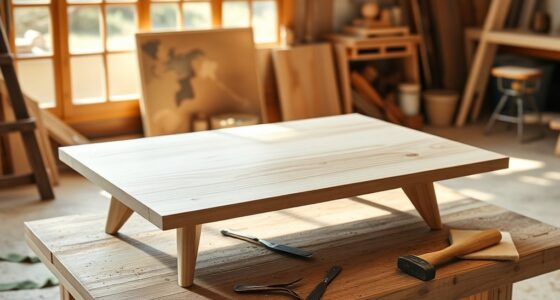To craft scented candles for a sensorial home design, start by choosing the right wax, like soy or beeswax, for a clean, even burn and pleasant appearance. Use a double boiler to melt the wax gently, then add your fragrance oils and stir thoroughly. Select the appropriate wick for your container and verify it’s centered before pouring. Carefully handle melting and mixing to create a warm, inviting ambiance—if you continue exploring, you’ll discover how to perfect every detail for a stunning, aromatic finish.
Key Takeaways
- Select high-quality wax types like soy or beeswax for optimal melting, appearance, and scent dispersion.
- Use a double boiler to gently and evenly melt wax, avoiding scorching and ensuring smooth pouring.
- Add fragrance oils after melting and stir thoroughly to achieve balanced, long-lasting aroma in the candle.
- Choose the appropriate wick size and material, ensuring it is centered for an even, clean burn that enhances scent throw.
- Proper handling and assembly of wax, fragrance, and wick result in aesthetically pleasing, functional candles that elevate home ambiance.

Scented candles have become a popular way to enhance your home’s ambiance, combining visual appeal with inviting aromas. When you’re crafting your own candles, focusing on the details can make a big difference in both their appearance and how they perform. One of the first things you’ll want to consider is wax melting. The type of wax you choose influences how smoothly it melts, how evenly it disperses fragrance, and its overall appearance. Soy wax, for example, melts at a lower temperature and offers a clean, even burn, while beeswax provides a warm, natural hue and a slight honey scent. When melting your wax, do so gently and steadily, avoiding rapid heating that can cause uneven melting or scorching. Using a double boiler setup helps control the temperature and prevents the wax from overheating, guaranteeing a smooth melt that’s perfect for pouring. As your wax melts, you can add your chosen fragrance oils, stirring gently to distribute the scent evenly throughout the mixture. This step is vital because well-incorporated fragrance enhances the sensory experience of your candle, making it more inviting when lit.
Next, wick selection plays a key role in the overall success of your candle. The wick not only supports the flame but also influences how well your candle burns, how evenly the wax melts, and the intensity of the scent throw. You want a wick that matches the size and type of your container and wax. For instance, a thicker wick might be necessary for larger containers or denser waxes to ensure a steady flame and proper wax melting. Conversely, a thinner wick works well with smaller jars or lighter waxes. When choosing your wick, consider the material—cotton wicks are common and reliable, but you might opt for wood wicks if you want a crackling sound or a more rustic aesthetic. Before pouring, make sure your wick is secured centered in the container, either by using a wick centering device or by tying it to a stick laid across the top. Proper wick selection and placement ensure that your candle burns evenly, reduces tunneling, and produces a consistent, pleasing scent throw.
Frequently Asked Questions
How Do I Choose the Right Scent for My Home’s Ambiance?
You should consider your home’s ambiance and your personal preferences when choosing a scent. Start with scent layering by combining complementary fragrances, like floral and citrus, to create a balanced atmosphere. Fragrance blending allows you to customize your candles, making them uniquely yours. Test small samples first to see how different scents interact, ensuring they match your mood and style. This way, your home smells inviting and perfectly aligned with your sensorial design.
What Safety Precautions Should I Follow When Making Candles?
Prioritize safety by practicing proper wax safety and selecting the right wick for your candle. Always work in a well-ventilated space, keep a fire extinguisher nearby, and never leave melting wax unattended. Use heat-resistant tools, avoid overfilling containers, and guarantee wicks are centered and secure. Following these safety steps helps prevent accidents, ensuring your candle-making remains a safe, satisfying, and successful craft.
How Long Do Homemade Scented Candles Typically Last?
Homemade scented candles usually last around 20 to 40 hours of candle burn time, depending on wax quality and wick size. To maximize wax longevity, trim the wick to about a quarter inch before each burn and avoid burning the candle for more than four hours at a time. Properly stored candles in a cool, dark place can also help prolong their lifespan and ensure you enjoy their aroma longer.
Can I Customize Candle Scents for Different Rooms?
Yes, you can customize candle scents for different rooms by creating personalized fragrances. Use scent layering techniques to combine complementary aromas, tailoring each candle to suit the room’s mood. For example, add calming lavender for bedrooms or invigorating citrus for kitchens. Experiment with different essential oils and blends, and remember to adjust the fragrance strength to achieve the perfect ambiance for each space.
What Are Eco-Friendly Materials for Candle Making?
You can use eco-friendly materials like natural waxes, such as soy, beeswax, or coconut wax, which are sustainable and clean-burning. For dyes, opt for plant-based dyes that are non-toxic and biodegradable. These choices help you create candles that are environmentally friendly, safe, and beautifully scented, enhancing your home’s sensorial experience while reducing your ecological footprint.
Conclusion
By now, you see how scented candles can truly transform your space into a sensory haven. With the right scents and placement, you’re not just decorating—you’re creating an ambiance that feels like a warm embrace. Remember, a well-chosen candle can turn any room into a cozy retreat. So go ahead, light up your home and let your senses do the talking; after all, it’s the little touches that make a house a home.








